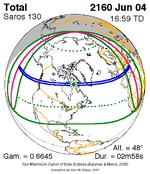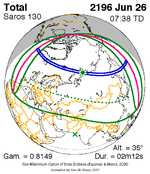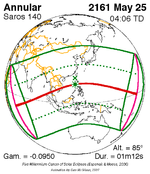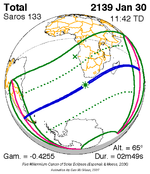Solar eclipse of March 30, 2052
| Solar eclipse of March 30, 2052 | |
|---|---|
| Type of eclipse | |
| Nature | Total |
| Gamma | 0.3238 |
| Magnitude | 1.0466 |
| Maximum eclipse | |
| Duration | 248 s (4 min 8 s) |
| Coordinates | 22°24′N 102°30′W / 22.4°N 102.5°W |
| Max. width of band | 164 km (102 mi) |
| Times (UTC) | |
| Greatest eclipse | 18:31:53 |
| References | |
| Saros | 130 (54 of 73) |
| Catalog # (SE5000) | 9623 |
A total solar eclipse will occur at the Moon's descending node of orbit on Saturday, March 30, 2052,[1] with a magnitude of 1.0466. A solar eclipse occurs when the Moon passes between Earth and the Sun, thereby totally or partly obscuring the image of the Sun for a viewer on Earth. A total solar eclipse occurs when the Moon's apparent diameter is larger than the Sun's, blocking all direct sunlight, turning day into darkness. Totality occurs in a narrow path across Earth's surface, with the partial solar eclipse visible over a surrounding region thousands of kilometres wide. Occurring about 1.5 days before perigee (on April 1, 2052, at 6:30 UTC), the Moon's apparent diameter will be larger.[2]
The path of totality will be visible from parts of central Mexico, the extreme southern tip of Texas, southeastern Louisiana, southeastern Alabama, Florida, Georgia, and South Carolina. A partial solar eclipse will also be visible for parts of Hawaii, North America, Central America, the Caribbean, and northern South America.
This will be the 2nd total eclipse visible from the Florida panhandle and southwest Georgia in 6.6 years. It will also be the last total solar eclipse visible in the United States until May 11, 2078.
Eclipse details
[edit]Shown below are two tables displaying details about this particular solar eclipse. The first table outlines times at which the moon's penumbra or umbra attains the specific parameter, and the second table describes various other parameters pertaining to this eclipse.[3]
| Event | Time (UTC) |
|---|---|
| First Penumbral External Contact | 2052 March 30 at 15:54:47.5 UTC |
| First Umbral External Contact | 2052 March 30 at 16:52:13.4 UTC |
| First Central Line | 2052 March 30 at 16:53:04.2 UTC |
| First Umbral Internal Contact | 2052 March 30 at 16:53:55.0 UTC |
| First Penumbral Internal Contact | 2052 March 30 at 17:57:37.9 UTC |
| Ecliptic Conjunction | 2052 March 30 at 18:28:31.3 UTC |
| Greatest Eclipse | 2052 March 30 at 18:31:52.9 UTC |
| Greatest Duration | 2052 March 30 at 18:33:58.8 UTC |
| Equatorial Conjunction | 2052 March 30 at 18:42:28.4 UTC |
| Last Penumbral Internal Contact | 2052 March 30 at 19:05:51.6 UTC |
| Last Umbral Internal Contact | 2052 March 30 at 20:09:40.8 UTC |
| Last Central Line | 2052 March 30 at 20:10:33.4 UTC |
| Last Umbral External Contact | 2052 March 30 at 20:11:25.9 UTC |
| Last Penumbral External Contact | 2052 March 30 at 21:08:49.5 UTC |
| Parameter | Value |
|---|---|
| Eclipse Magnitude | 1.04664 |
| Eclipse Obscuration | 1.09545 |
| Gamma | 0.32385 |
| Sun Right Ascension | 00h39m33.8s |
| Sun Declination | +04°15'25.9" |
| Sun Semi-Diameter | 16'00.7" |
| Sun Equatorial Horizontal Parallax | 08.8" |
| Moon Right Ascension | 00h39m10.3s |
| Moon Declination | +04°34'05.5" |
| Moon Semi-Diameter | 16'29.6" |
| Moon Equatorial Horizontal Parallax | 1°00'31.8" |
| ΔT | 85.4 s |
Eclipse season
[edit]This eclipse is part of an eclipse season, a period, roughly every six months, when eclipses occur. Only two (or occasionally three) eclipse seasons occur each year, and each season lasts about 35 days and repeats just short of six months (173 days) later; thus two full eclipse seasons always occur each year. Either two or three eclipses happen each eclipse season. In the sequence below, each eclipse is separated by a fortnight.
| March 30 Descending node (new moon) |
April 14 Ascending node (full moon) |
|---|---|
 |

|
| Total solar eclipse Solar Saros 130 |
Penumbral lunar eclipse Lunar Saros 142 |
Related eclipses
[edit]Eclipses in 2052
[edit]- A total solar eclipse on March 30.
- A penumbral lunar eclipse on April 14.
- An annular solar eclipse on September 22.
- A partial lunar eclipse on October 8.
Metonic
[edit]- Preceded by: Solar eclipse of June 11, 2048
- Followed by: Solar eclipse of January 16, 2056
Tzolkinex
[edit]- Preceded by: Solar eclipse of February 16, 2045
- Followed by: Solar eclipse of May 11, 2059
Half-Saros
[edit]- Preceded by: Lunar eclipse of March 25, 2043
- Followed by: Lunar eclipse of April 4, 2061
Tritos
[edit]- Preceded by: Solar eclipse of April 30, 2041
- Followed by: Solar eclipse of February 28, 2063
Solar Saros 130
[edit]- Preceded by: Solar eclipse of March 20, 2034
- Followed by: Solar eclipse of April 11, 2070
Inex
[edit]- Preceded by: Solar eclipse of April 20, 2023
- Followed by: Solar eclipse of March 10, 2081
Triad
[edit]- Preceded by: Solar eclipse of May 30, 1965
- Followed by: Solar eclipse of January 30, 2139
Solar eclipses of 2051–2054
[edit]This eclipse is a member of a semester series. An eclipse in a semester series of solar eclipses repeats approximately every 177 days and 4 hours (a semester) at alternating nodes of the Moon's orbit.[4]
The partial solar eclipse on August 3, 2054 occurs in the next lunar year eclipse set.
| Solar eclipse series sets from 2051 to 2054 | ||||||
|---|---|---|---|---|---|---|
| Descending node | Ascending node | |||||
| Saros | Map | Gamma | Saros | Map | Gamma | |
| 120 | April 11, 2051 Partial |
1.0169 | 125 | October 4, 2051 Partial |
−1.2094 | |
| 130 | March 30, 2052 Total |
0.3238 | 135 | September 22, 2052 Annular |
−0.448 | |
| 140 | March 20, 2053 Annular |
−0.4089 | 145 | September 12, 2053 Total |
0.314 | |
| 150 | March 9, 2054 Partial |
−1.1711 | 155 | September 2, 2054 Partial |
1.0215 | |
Saros 130
[edit]This eclipse is a part of Saros series 130, repeating every 18 years, 11 days, and containing 73 events. The series started with a partial solar eclipse on August 20, 1096. It contains total eclipses from April 5, 1475 through July 18, 2232. There are no annular or hybrid eclipses in this set. The series ends at member 73 as a partial eclipse on October 25, 2394. Its eclipses are tabulated in three columns; every third eclipse in the same column is one exeligmos apart, so they all cast shadows over approximately the same parts of the Earth.
The longest duration of totality was produced by member 30 at 6 minutes, 41 seconds on July 11, 1619. All eclipses in this series occur at the Moon’s descending node of orbit.[5]
| Series members 41–62 occur between 1801 and 2200: | ||
|---|---|---|
| 41 | 42 | 43 |
 November 9, 1817 |
 November 20, 1835 |
 November 30, 1853 |
| 44 | 45 | 46 |
 December 12, 1871 |
 December 22, 1889 |
 January 3, 1908 |
| 47 | 48 | 49 |
 January 14, 1926 |
 January 25, 1944 |
 February 5, 1962 |
| 50 | 51 | 52 |
 February 16, 1980 |
 February 26, 1998 |
 March 9, 2016 |
| 53 | 54 | 55 |
 March 20, 2034 |
 March 30, 2052 |
 April 11, 2070 |
| 56 | 57 | 58 |
 April 21, 2088 |
 May 3, 2106 |
 May 14, 2124 |
| 59 | 60 | 61 |
 May 25, 2142 |
 June 4, 2160 |
 June 16, 2178 |
| 62 | ||
 June 26, 2196 | ||
Metonic series
[edit]The metonic series repeats eclipses every 19 years (6939.69 days), lasting about 5 cycles. Eclipses occur in nearly the same calendar date. In addition, the octon subseries repeats 1/5 of that or every 3.8 years (1387.94 days). All eclipses in this table occur at the Moon's descending node.
| 22 eclipse events between June 12, 2029 and November 4, 2116 | ||||
|---|---|---|---|---|
| June 11–12 | March 30–31 | January 16 | November 4–5 | August 23–24 |
| 118 | 120 | 122 | 124 | 126 |
 June 12, 2029 |
 March 30, 2033 |
 January 16, 2037 |
 November 4, 2040 |
 August 23, 2044 |
| 128 | 130 | 132 | 134 | 136 |
 June 11, 2048 |
 March 30, 2052 |
 January 16, 2056 |
 November 5, 2059 |
 August 24, 2063 |
| 138 | 140 | 142 | 144 | 146 |
 June 11, 2067 |
 March 31, 2071 |
 January 16, 2075 |
 November 4, 2078 |
 August 24, 2082 |
| 148 | 150 | 152 | 154 | 156 |
 June 11, 2086 |
 March 31, 2090 |
 January 16, 2094 |
 November 4, 2097 |
 August 24, 2101 |
| 158 | 160 | 162 | 164 | |
 June 12, 2105 |
 November 4, 2116 | |||
Tritos series
[edit]This eclipse is a part of a tritos cycle, repeating at alternating nodes every 135 synodic months (≈ 3986.63 days, or 11 years minus 1 month). Their appearance and longitude are irregular due to a lack of synchronization with the anomalistic month (period of perigee), but groupings of 3 tritos cycles (≈ 33 years minus 3 months) come close (≈ 434.044 anomalistic months), so eclipses are similar in these groupings.
| Series members between 1801 and 2200 | ||||
|---|---|---|---|---|
 March 14, 1801 (Saros 107) |
 February 12, 1812 (Saros 108) |
 January 12, 1823 (Saros 109) |
 November 10, 1844 (Saros 111) | |
 August 9, 1877 (Saros 114) |
 July 9, 1888 (Saros 115) |
 June 8, 1899 (Saros 116) | ||
 May 9, 1910 (Saros 117) |
 April 8, 1921 (Saros 118) |
 March 7, 1932 (Saros 119) |
 February 4, 1943 (Saros 120) |
 January 5, 1954 (Saros 121) |
 December 4, 1964 (Saros 122) |
 November 3, 1975 (Saros 123) |
 October 3, 1986 (Saros 124) |
 September 2, 1997 (Saros 125) |
 August 1, 2008 (Saros 126) |
 July 2, 2019 (Saros 127) |
 June 1, 2030 (Saros 128) |
 April 30, 2041 (Saros 129) |
 March 30, 2052 (Saros 130) |
 February 28, 2063 (Saros 131) |
 January 27, 2074 (Saros 132) |
 December 27, 2084 (Saros 133) |
 November 27, 2095 (Saros 134) |
 October 26, 2106 (Saros 135) |
 September 26, 2117 (Saros 136) |
 August 25, 2128 (Saros 137) |
 July 25, 2139 (Saros 138) |
 June 25, 2150 (Saros 139) |
 May 25, 2161 (Saros 140) |
 April 23, 2172 (Saros 141) |
 March 23, 2183 (Saros 142) |
 February 21, 2194 (Saros 143) | |||
Inex series
[edit]This eclipse is a part of the long period inex cycle, repeating at alternating nodes, every 358 synodic months (≈ 10,571.95 days, or 29 years minus 20 days). Their appearance and longitude are irregular due to a lack of synchronization with the anomalistic month (period of perigee). However, groupings of 3 inex cycles (≈ 87 years minus 2 months) comes close (≈ 1,151.02 anomalistic months), so eclipses are similar in these groupings.
| Series members between 1801 and 2200 | ||
|---|---|---|
 September 7, 1820 (Saros 122) |
 August 18, 1849 (Saros 123) |
 July 29, 1878 (Saros 124) |
 July 10, 1907 (Saros 125) |
 June 19, 1936 (Saros 126) |
 May 30, 1965 (Saros 127) |
 May 10, 1994 (Saros 128) |
 April 20, 2023 (Saros 129) |
 March 30, 2052 (Saros 130) |
 March 10, 2081 (Saros 131) |
 February 18, 2110 (Saros 132) |
 January 30, 2139 (Saros 133) |
 January 10, 2168 (Saros 134) |
 December 19, 2196 (Saros 135) |
|
Notes
[edit]- ^ "March 30, 2052 Total Solar Eclipse". timeanddate. Retrieved 15 August 2024.
- ^ "Moon Distances for London, United Kingdom, England". timeanddate. Retrieved 15 August 2024.
- ^ "Total Solar Eclipse of 2052 Mar 30". EclipseWise.com. Retrieved 15 August 2024.
- ^ van Gent, R.H. "Solar- and Lunar-Eclipse Predictions from Antiquity to the Present". A Catalogue of Eclipse Cycles. Utrecht University. Retrieved 6 October 2018.
- ^ "NASA - Catalog of Solar Eclipses of Saros 130". eclipse.gsfc.nasa.gov.
References
[edit]- Earth visibility chart and eclipse statistics Eclipse Predictions by Fred Espenak, NASA/GSFC




